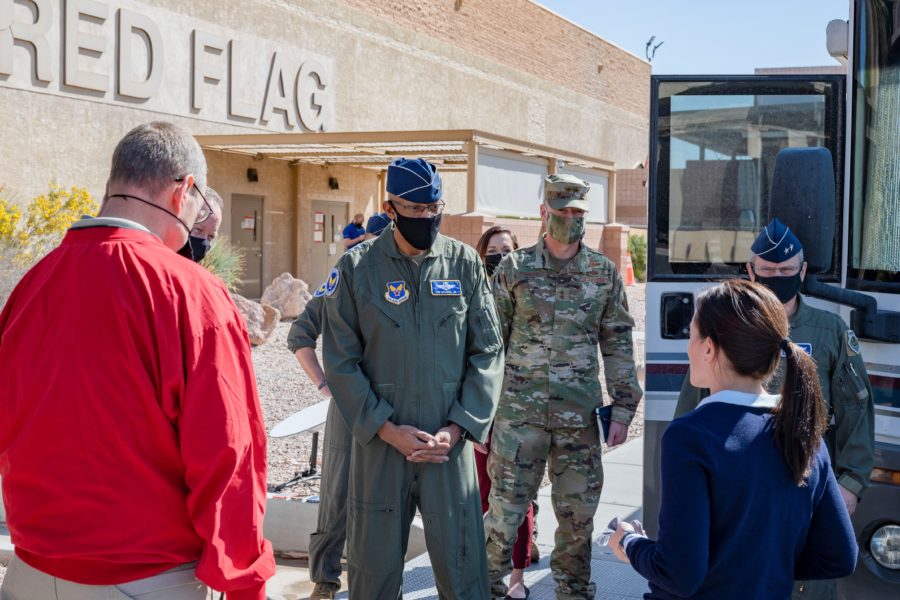The Air Force is experimenting with the use of 5G technology to provide mobile, distributed command and control, and it eventually hopes to be able to do away altogether with fixed location air operations centers, according to the service’s deputy chief technology officer.
“Today’s air operation centers are static, easy targets to hit that are considered a huge … liability. There’s no resilience there,” James “Rob” Beutel said April 7.
He told a virtual event on 5G staged by AFCEA DC that experimental deployments at Nellis Air Force Base, Nev., used special portable cell towers that could be stood up and torn down in less than an hour. “We’re looking at being able to modularize the entire air operation center or any other C2 node that’s out there … [It’s] disaggregated and distributed command and control.”
The enormous bandwidth and ultra high speed data transport offered by 5G made it possible to imagine AOC operations being dispersed over several geographic locations and even being made mobile, without any fixed location at all.
“You can not only disperse it, but keep it on the move and make it very difficult for an adversary to deal with—whether it’s via kinetic or any other type of effect you’re trying to bring against us,” Beutel said.
The $22 million, three-year experiment uses infrastructure built by AT&T. The plan and later the contract were unveiled last year, but this is the first time officials have discussed progress this year.
Nellis is one of a series of 12 experimental deployments of 5G technology that the Air Force announced in two batches last year.
Beutel said another of the deployments, at Joint Base Pearl Harbor-Hickam, Hawaii, would install 5G connectivity on the flightline, and specifically for aircraft maintenance. “With today’s aircraft, there’s a tremendous amount of data onboard, that even when the plane lands, it’s hard to get off … 5G is going to allow us to get that large amount of data off [the aircraft], get it off quickly, [and] be able to analyze it right there at the edge.”
On-the-spot analysis of aeroengine data using artificial intelligence, for example, would enable maintainers to “immediately determine whether issues have occurred before, … increasing our resilience,” he said. 5G technology also would allow the deployment of new mobile headsets for maintainers, bringing them virtual and augmented reality capabilities. “So that while they’re working on a part, it’s not just static documentation they’re working from, but 3D models” that overlay the real item. The equipment would also offer “remote communication with subject matter experts when they’re dealing with the toughest problems, to be able to get at things immediately.”
Current readiness levels of about 75 to 80 percent “could significantly increase” as a result of the new technologies, slashing costs, Beutel said.
The experiments showcased the “hybrid approach” being taken across DOD to 5G technology, Beutel said—where commercial providers would provide conventional utility-style phone service on bases, for individual customers and for the military enterprise.
“We’re looking at a lot of cases where we’re still going to want to have 5G as a service”—akin to the way the Air Force is now buying enterprise IT as a service, he said. “We’re finding that it becomes almost more of a commodity from the network piece of it. It’s what we do with it on top of it that we would need to keep in house, and I think that’s one of the interesting things about 5G. There’s going to be portions of it that it obviously makes sense to commoditize, and there’s going to be things that we’re going to want to keep a close hold on, the secret sauce, if you will.”
Because 5G enables a network to be divided—not just into core versus periphery, but into horizontal “slices,” it’s easily imaginable that the DOD could run its own unique services over a commodity 5G network.
However, some elements of 5G deployment, Beutel acknowledged, the military would have to handle on its own—like expeditionary force deployments in a hot zone. “That is just something we’re going to have to own ourselves. I don’t know that there’s going to be too many 5G service providers out there that are going to want to, you know, tag along, maybe almost like a reporter would, to provide 5G services [at the front line]. I don’t think that’s a likelihood.”

